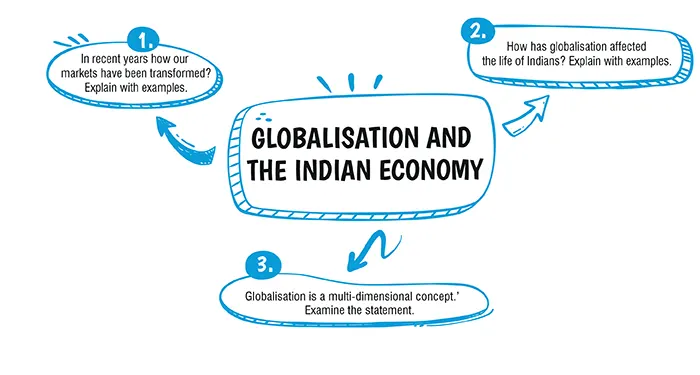Home / Boards / CBSE / Important Questions / Class 10 / Social Science / Globalisation and the Indian Economy
Table of Contents

Ans. (d)
Explanation:
These large MNCs have tremendous power to determine price,quality, delivery, and labour conditions for these distant producers.
Ans. (c)
Explanation:
Globalisation has created conditions for increased job opportunities.
Explanation:
Transformation of Markets in recent years :
(i) The advent of globalisation and the policy of liberalisation has opened the market to the world. The economy of our country has rapidly grown with the onset of LPG, i.eLiberalisation, Privatization and Globalization reforms since 1991.
(ii) MNCs play a vital role in the world market and as a result, foreign trade and investment in the country has increased. MNCs are playing a major role in the market by introducing exchange oftechnology between countries.
(iii) Foreign trade affects the integration of domestic markets in different countries.
(iv) Also, globalisation has enabled some large Indian companies to emerge as multinational companies themselves. For example, Tata Motors (automobiles), Infosys (IT), Ranbaxy (medicines) aresome Indian companies which are spreading their operations worldwide.
Explanation:
Globalisation has contributed in booming the Indian economy in following ways :
(i) Greater competition among producers resulting from globalisation is a great advantage to consumers as there is wider choice regarding every product before them.
(ii) Due to globalisation, many MNCs have increased their investments in India, this has not only helped in the inflow of capital but also largely helped in employment generation.
(iii) Local companies supplying raw materials to industries that have been set as a result of globalisation, have prospered leaps and bounds.
(iv) Large Indian companies have emerged as multinational companies. This has helped our country to increase our contacts around the world. Globalisation has helped increase our GDP and per capita income, thus making the living standards better across the globe.
Explanation:
Globalisation is a multi-dimensional concept and the following points support it:
(i) Globalisation brings countries together in terms of their political relationships. When countries are trade dependent on each other, it helps to bring better political harmony among them.
(ii) Economically, globalisation has resulted in the flow of commodities, people and capital. Through it, the economies of countries grew to manifolds, also resulting in curbing the economic disparities.
(iii) Another dimension of globalisation is the exchange of ideas and technology.
(iv) Globalisation along with trade of ideas, capital, commodity and people also leads to homogenisation of communities. In this way, it supports the cultural acceptance among heterogeneous communities.
(v) The opening up of new sectors, change in global lifestyle, dominance of mass and social media and mass tourism are also the dimensions of globalisation.
| Chapter No. | Chapter Name |
|---|---|
| History | |
| Chapter 1 | The Rise of Nationalism in Europe |
| Chapter 2 | Nationalism in India |
| Chapter 3 | The Making of a Global World |
| Chapter 4 | The Age of Industrialization |
| Chapter 5 | Print Culture and the Modern World |
| Geography | |
| Chapter 6 | Resources and Development |
| Chapter 7 | Forest and Wildlife Resources |
| Chapter 8 | Water Resources |
| Chapter 9 | Agriculture |
| Chapter 10 | Minerals and Energy Resources |
| Chapter 11 | Manufacturing Industries |
| Political Science | |
| Chapter 12 | Power – sharing |
| Chapter 13 | Federalism |
| Chapter 14 | Gender, Religion and Caste |
| Chapter 15 | Political Parties |
| Chapter 16 | Outcomes of Democracy |
| Economics | |
| Chapter 17 | Development |
| Chapter 18 | Sectors of the Indian Economy |
| Chapter 19 | Money and Credit |
| Chapter 20 | Globalization and The Indian Economy |
| Chapter Wise Important Questions for CBSE Board Class 10 Economics |
|---|
| Development |
| Sectors of the Indian Economy |
| Money and Credit |
| Globalization and The Indian Economy |
CBSE Important Questions Class 10
ICSE Important Questions Class 10
CBSE Important Questions Class 10
ICSE Important Questions Class 10